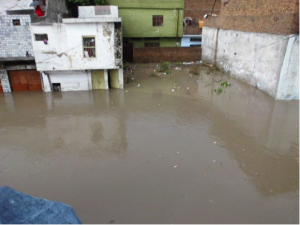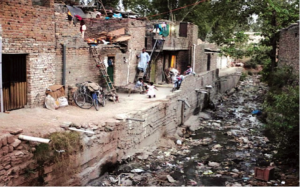Today, 25 November, marks the United Nations’ International Day for the Elimination of Violence against Women. In this post, King’s Water PhD Researcher Amiera Sawas reflects on the role of water, particularly water for sanitation and hygiene (WASH), in gender-based violence.
There is a new growing field of research that challenges dominant assumptions about the drivers of violence in urban centres of the Global South. In 2012, O’Neill and Rogers (2012) introduced the idea of ‘infrastructural violence’: how infrastructure (housing, roads, streets, water supply and sanitation systems) layered with hierarchies of power translates into physical and psychological harm. The recent, tragic cases of sexual violence in India, where young women were raped and murdered while searching for a spot for defecation[1], and the brutal gang-rape and murder of a physiotherapy student on a moving private bus in Nirybhya, Delhi in 2012[2], have made it all too clear that poor infrastructure creates opportunities for violence [3][4]. A less explored, and perhaps more common, element of infrastructural violence is how poor infrastructure changes the way people interact with each other, potentially driving conflict and violence. These sorts of drivers can only be understood in their complexity by credible, extensive, ground-level research in the cities.
I am part of a largely Pakistani team of researchers investigating the links between violence, vulnerability and gender in Karachi and Rawalpindi-Islamabad urban agglomerations[5]. We spent over two years conducting surveys and ethnographic research with over 2400 people in low-income communities. The results do not only confirm some ideas we had originally about the types of violence experienced in these cities, but they also challenge some strongly held beliefs held by policymakers. One of the most interesting findings has been the nexus between access to WASH (Water, Sanitation and Hygiene), gender and violence.
WASH, Gender and Violence
Pakistan has a bad rep: it is rare to hear any news related to the country which does not mention political or gendered violence. It is true that violence forms part of daily life for many of the poorer residents of its cities, having affected 79% of our respondents in Rawalpindi-Islamabad and 72% in Karachi. But according to our research, the drivers, perpetrators and experiences of violence are much more complex and variable than the media would have us believe. The WASH-Gender-Violence nexus is a pertinent example. When I mention it, people usually look perplexed – how can WASH lead to violence? Why are you throwing gender into an already vague mix?? Well, when you observe the way ideas and expectations of gender performances play out in a context of poor access to WASH resources, the links start to become clear. While this is a very new field of enquiry, another research team from WaterAid, Share Research and Loughborough University, have developed a toolkit for practitioners who wish to prevent the WASH-Gender-violence dynamic.
There were certainly some statistical links between WASH and violence. 485 of 2449 (20%) people across Karachi and Rawalpindi-Islamabad told us poor Water, Sanitation and Hygiene (WASH) was a significant or huge driver of violent conflicts inside and outside the home, and another 564 (23%) said it was to a moderate extent. Over 80% of all our respondents who had poor or no access to water supply had experienced violence, compared to only 10% who had excellent water supply. It is important to define what we mean by violence, though. We concluded, based on extensive scoping studies, that our definition would be any actual harm and/or threat of harm.
The violence dynamics differ in Karachi and Rawalpindi-Islamabad, due to different political-economic contexts. There are both similarities and differences in their WASH-gender-violence nexuses. We found that WASH infrastructure drives a range of violence in both cities. The impact of poor access to these basic necessities is not only opportunistic for violent entrepreneurs, but – crucially – creates frustrations between families and neighbours who are already under intense pressure from the insecurity of everyday life in urban Pakistan
In Karachi, there is a major problem with water mafias[6],[7]. These operate across informal and formal settlements by illegally tapping water supply and then charging residents extortionate prices for access. These mafias are populated by young males who project their ideas of masculinity (to be a good earner; to be strong and untouchable) through the process, operating in violent ways. They work with impunity and threaten or hurt anyone who is seen to be getting in the way of business. The late Parween Rehman, director of a local NGO, was allegedly assassinated by the water mafia when they felt threatened by research she was conducting on their activities[8]. Through organisations like water mafias, access to water has been capitalised upon by groups of people who have then changed local security dynamics for the rest of the population.
Several of our respondents also lamented over the immense stress that concerns over access to water was causing within the household. The dual water tariffs – to the government and the mafias – ‘have crippled’ them. This has influenced household dynamics, as males are expected to bring home sufficient money to pay these extortionate bills in a very tough economic climate and females are expected to do all their household chores using minimal water. These stresses cause frustrations which can lead to domestic violence,
“My father becomes so tense about the water bill. He tells us not to use water all day – but how can we perform our duties without it? We cannot go outside for water. When the bill comes we try to hide it from him, otherwise he beats my mother and me a lot because of his frustration” (Female, 22, Bin Qasim Town, Karachi)
Inadequate sanitation is also pervasive in Karachi and leads to conflicts inside and outside the home. Solid and liquid waste litters the streets, doorways and empty plots. It has been a trigger for physical conflicts between shop owners and pedestrians and has a major impact upon health and quality of life, leading to stress over livelihoods and the cost of medicines. As one respondent described:
“Sometimes I feel that our whole area is a garbage bin. My nieces get ill half of the year due to worsening hygiene situation of the area. They are unhealthy and a substantial part of our income is spent on medication. My sister in law continuously insists to my brother to leave this area for the sake of the children’s health. But my brothers can’t leave due their commitments to our shops. This has turned into a serious issue in my home. Basically this is the main issue behind our constant fights”
This reflects the way the WASH-gender-violence nexus plays out in the other urban agglomeration we researched, Rawalpindi-Islamabad. There, forms of infrastructural violence dominate, especially those related to urban vulnerability. The vulnerability-violence nexus has been explored by researchers[9],[10],[11],[12], but the fact it could be a larger determinant of violent experiences than political or social violence may be novel in our data. Vulnerability to natural hazards is high because the majority of low-income communities reside in informal or insecure settlements on the banks of the local perennial streams.

When heavy rains occur, homes are often flooded and the surrounding streets blocked, preventing access even for emergency vehicles[13],[14]. Inhabitants are likely to remain home from work to save homes and belongings. The situation is intense, made worse by the fact that breadwinning males are no longer earning money. Respondents, both male and female, told us that this leads to psychological violence, manifesting itself in frustration and increased domestic violence towards women.
“During the rainy season we became psychologically ill; we become completely paralyzed; our livelihood gets disturbed a lot and we became irritated with each other” (Female, 30 years old, Dokh Naju, Rawalpindi)
Even in times without floods, potable water is not always available, leading to tensions between female neighbours,
“Researcher: Last time when we visited your locality some women were being very aggressive towards each other in the street. What was the reason?
Respondent: Yes you are right, they were arguing because of lack of water facility. Actually here we use supply water which is available after one day and sometimes we are deprived from water for a long time. That’s why the day when supply water is available everyone tries to be first to get water” (Female, 32, Arya Mohalla, Rawalpindi)
Pakistan is a diverse country. Ideas and expectations of gender vary across communities. Poor access to WASH intersects with a diversity of gendered norms, and thus resulting violence occurs with divergent severities. For example, in one community we researched, there were very conservative ideas about the roles of women and men, with masculinity demonstrated through physical strength and expectations of the female role centred around household and domestic stability. When women are unable to do their chores properly, males can become violent:
“Yesterday a male neighbor was beating his daughter and wife because his wife brought unclean water from the well and he got angry with her. That’s how people treat their wives in this community” (Female, 19 years, Islamabad)
Solid waste, like in Karachi, also causes frustrations which can lead to violence,
“(on the issue of solid waste in the streets) these issues cause frustration in people, especially in males – they are responsible for the whole family. They become more and more unhappy, then they obviously release their anger, sometimes beating us and sometimes having conflicts with neighbours” (27 year old female, Dokh Saidan, Rawalpindi)

At least in urban Pakistan, infrastructural violence is dominant. Its severity drives other forms of violence. The same is likely true in other rapidly developing cities in the Global South. While planners are increasingly keen to improve urban design to prevent opportunistic crime[15], more needs to be done in terms of combatting infrastructure as a driver of violence. The violence, gender and WASH toolkit is certainly a pioneering attempt to integrate the mitigation of gender-based violence in WASH programmes. More holistic planning approaches that include all basic infrastructure, such as Cape Town’s Urban Upgrading for Violence Prevention Programme, are also emerging[16],[17]. Still, a more systematic approach to understanding how access to infrastructure, gender and violence are linked is needed, starting with more evidence-based research that can inform policy for governments, civil society and donors in their attempts to reduce gendered violence.
References
[1] http://www.theguardian.com/world/2014/may/29/indian-sisters-gang-raped-hanged-tree
[2] http://www.theguardian.com/world/2013/sep/10/delhi-gang-rape-india-women
[3] http://www.huffingtonpost.co.uk/barbara-frost/sanitation-in-india_b_5563520.html
[4] http://www.amnesty.org/en/library/asset/AFR32/002/2010/en/12a9d334-0b62-40e1-ae4a-e5333752d68c/afr320022010en.pdf
[5] http://www.idrc.ca/EN/Programs/Social_and_Economic_Policy/Governance_Security_and_Justice/Pages/107363.aspx
[6] http://arynews.tv/en/seventy-percent-of-karachi-without-water/
[7] http://www.stimson.org/images/uploads/Karachi_Case_Study.pdf
[8] http://tribune.com.pk/story/735806/perween-rehmans-murder-police-extend-investigation-to-water-land-mafias/
[9] http://www.ids.ac.uk/publication/unemployment-service-provision-and-violence-reduction-policies-in-urban-maharashtra
[10] http://eth.sagepub.com/content/13/4/531.short
[11] http://societyandspace.com/reviews/reviews-archive/javier-auyero-and-debora-alejandra-swistun-flammable-environmental-suffering-in-an-argentine-shantytown-reviewed-by-thomas-perreault/
[12] http://opendocs.ids.ac.uk/opendocs/handle/123456789/2871#.VDbJ4vldXL4
[13] http://tribune.com.pk/story/761931/floods-2014-rain-wreaks-havoc-in-rawalpindi-outskirts/
[14] http://www.dawn.com/news/1130440
[15] http://www.citylab.com/crime/2014/06/how-urban-design-could-help-reduce-rape-in-india/372612/
[16] http://dirt.asla.org/2014/05/01/in-cape-town-urban-design-reduces-violence/
Comments are closed.